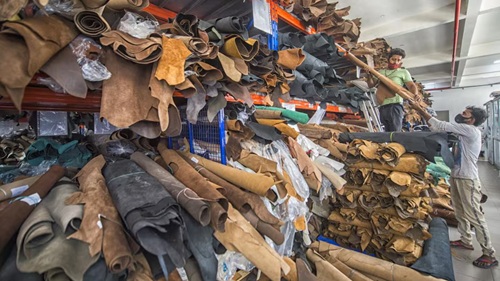The leather industry has long been one of India’s most traditional yet globally competitive sectors, known for its craftsmanship, export potential, and employment generation. In 2025, this industry stands at a crucial crossroads — balancing its heritage strengths with modernization, sustainability, and global trade dynamics. With over 4 million people employed and thousands of small and medium enterprises operating across tanning, footwear, and accessories, India remains one of the world’s top producers of leather and leather goods. However, new environmental regulations, global fashion trends, and evolving consumer preferences are reshaping how the sector operates and competes.

Current Market Overview
According to the Council for Leather Exports (CLE), India’s leather, non-leather footwear, and leather product exports rose by 25% in FY 2024–25, touching USD 5.7 billion. The industry now targets USD 7 billion in exports by FY 2025–26. This recovery is driven by strong demand in key markets like the U.S., U.K., and Germany, along with renewed domestic consumption post-pandemic.
India currently contributes around 13% of the world’s leather production, with Tamil Nadu, Uttar Pradesh, West Bengal, Telangana, and Punjab serving as major leather clusters. Beyond exports, the domestic market for leather footwear, bags, and accessories has also grown substantially due to rising incomes and fashion awareness among Indian consumers.
Key Growth Drivers in 2025
1. Government Policy & Incentives
The Indian Footwear and Leather Development Programme (IFLDP) continues to play a vital role in infrastructure development, skill training, and cluster upgradation. Through initiatives like the Production Linked Incentive (PLI) and RoDTEP, the government aims to enhance competitiveness and attract foreign investment. State-level leather parks and common facility centers are also helping smaller manufacturers modernize their operations.
2. Rising Global & Domestic Demand
The global appetite for quality yet affordable leather goods has helped Indian exporters regain momentum in 2025. Domestically, the shift toward premium fashion and formal wear has led to increased demand for high-quality leather footwear, belts, and handbags.
3. Focus on Value Addition & Design
A major transformation underway is the industry’s focus on design, innovation, and branding. Many Indian manufacturers are moving from raw material export to creating finished, branded products with higher margins. Investments in design institutes, 3D modeling, and international collaborations are helping Indian brands compete with Italian and Chinese counterparts.
4. Sustainability & Eco-Friendly Practices
The tanning process — traditionally seen as polluting — is undergoing a green shift. Units are investing in Zero Liquid Discharge (ZLD) systems, chrome-free tanning, and certified eco-leathers. International buyers increasingly demand environmentally responsible sourcing, and India’s exporters are aligning with these global standards.
Challenges Ahead
Despite its growth, the Indian leather sector faces several challenges in 2025:
- Environmental compliance costs are rising as global importers demand stricter standards.
- Dependence on imported components like soles, dyes, and machinery increases production costs.
- Skill and technology gaps persist in smaller units, especially in design, quality assurance, and digital marketing.
- Trade barriers and tariffs, especially from the U.S. and EU markets, continue to affect profit margins.
- Animal welfare concerns and synthetic leather alternatives are also influencing buyer sentiment in certain markets.
Addressing these issues will be critical for maintaining India’s competitive edge in the global leather trade.
Opportunities in 2025 and Beyond
- Brand India Leather: Promoting Indian craftsmanship and heritage through global branding and storytelling.
- Sustainable Leather Exports: Capturing eco-conscious markets with certified “green leather” products.
- Technological Upgradation: Automation in cutting, stitching, and finishing can raise productivity.
- Domestic Market Expansion: Leveraging India’s 1.4 billion consumers through e-commerce, fashion retail, and luxury segments.
- Skill Development: Collaborations between government, CLE, and private design schools to train the next generation of artisans and designers.
Strategic Recommendations for Businesses
- Invest in Sustainability — adopt cleaner technologies, waste management systems, and sustainable sourcing to meet global expectations.
- Enhance Design & Branding — build your own brands and focus on storytelling around craftsmanship and eco-friendliness.
- Diversify Export Markets — explore regions like Latin America, Africa, and the Middle East to reduce over-dependence on the West.
- Leverage Government Schemes — utilize IFLDP, RoDTEP, and export promotion incentives for modernization and expansion.
- Strengthen Digital Presence — create online B2B/B2C sales channels to reach both domestic and international customers directly.
Conclusion
The leather industry in India in 2025 reflects a powerful blend of tradition and transformation. From handcrafted tanneries to modern design studios, the sector is reimagining its identity — cleaner, more innovative, and globally competitive. With the right mix of sustainability, technology, and policy support, India is poised not only to retain its position among the world’s top leather exporters but also to evolve into a design-led, value-driven powerhouse.
If 2024 was the year of recovery, 2025 is the year of reinvention — where Indian leather steps confidently into a global future shaped by innovation, responsibility, and craftsmanship.

